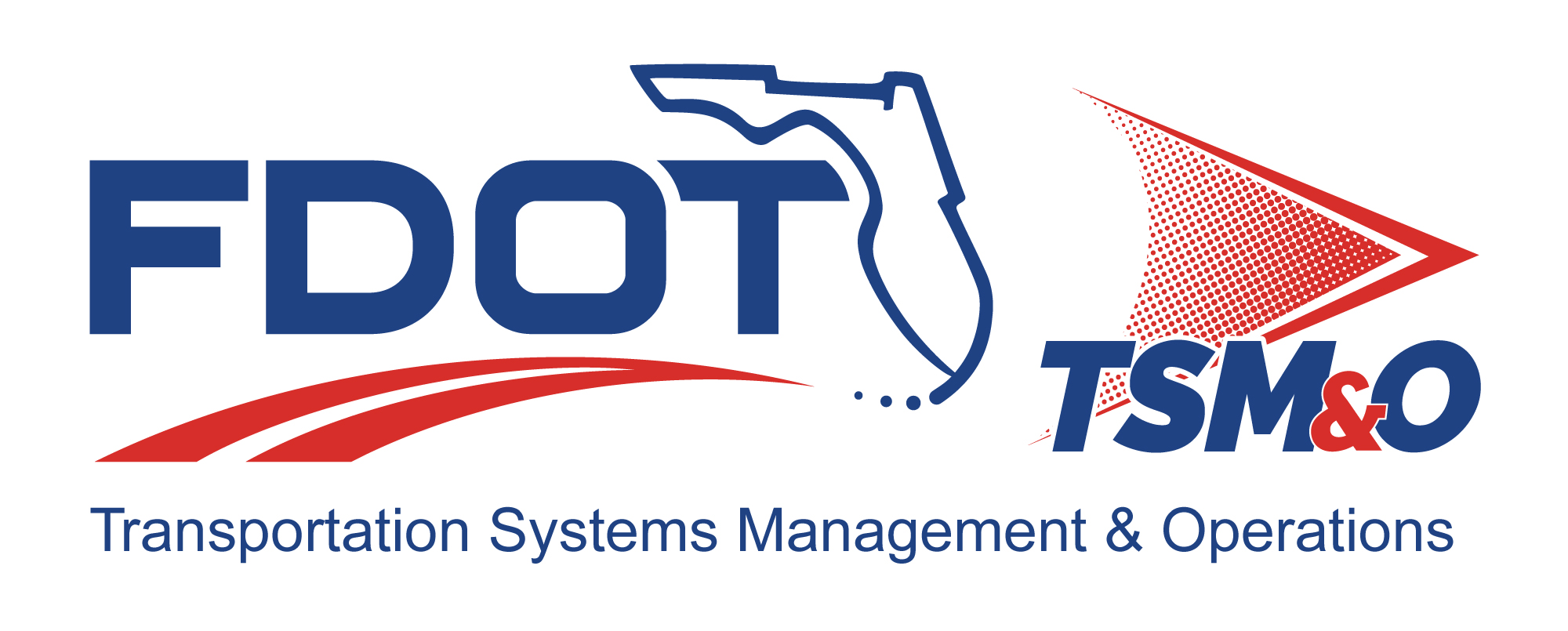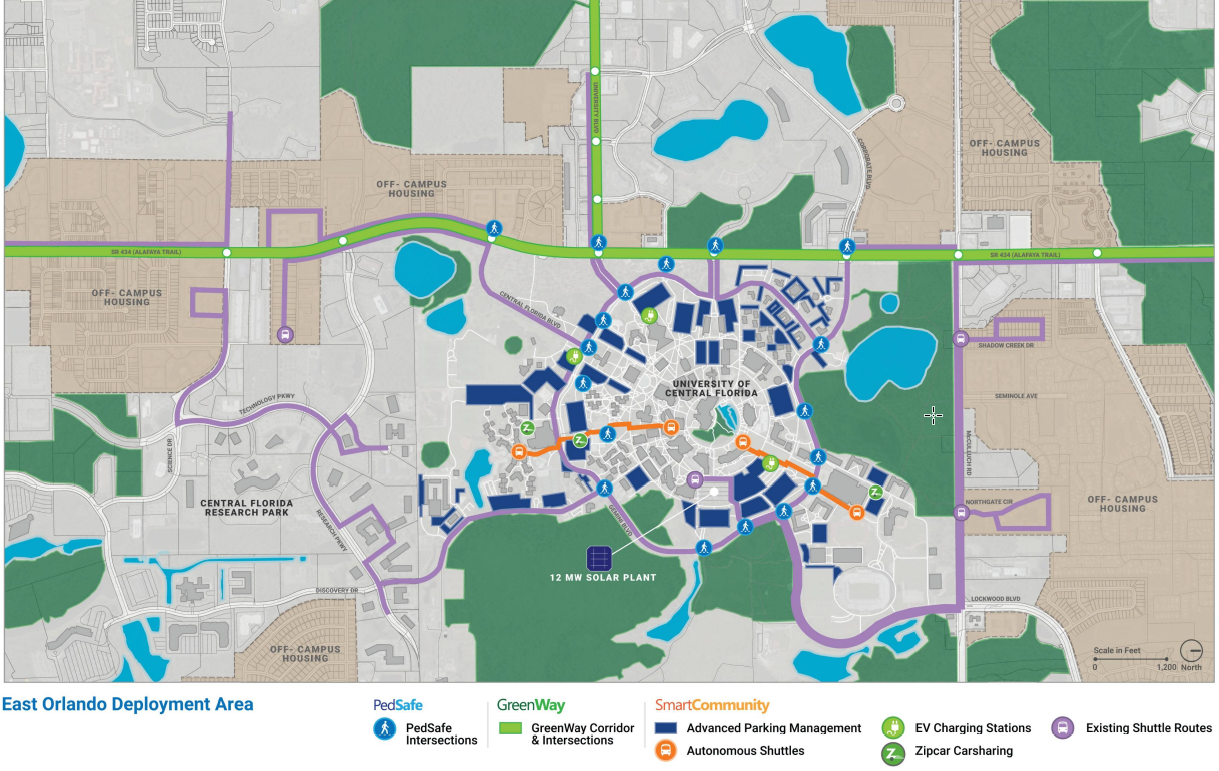Connected & Autonomous Vehicle Program Resources
|
ATCMTD
The Florida Department of
Transportation (FDOT) applied for the grant in
collaboration with MetroPlan Orlando and UCF. The funds
came from the FHWA Advanced Transportation and
Congestion Management Technologies Deployment (ATCMTD)
grant program, which funds cutting-edge technologies
that are ready to be deployed to enhance existing
traffic capacity for commuters and businesses. For
more information on the ATCMTD Grant, click
here.
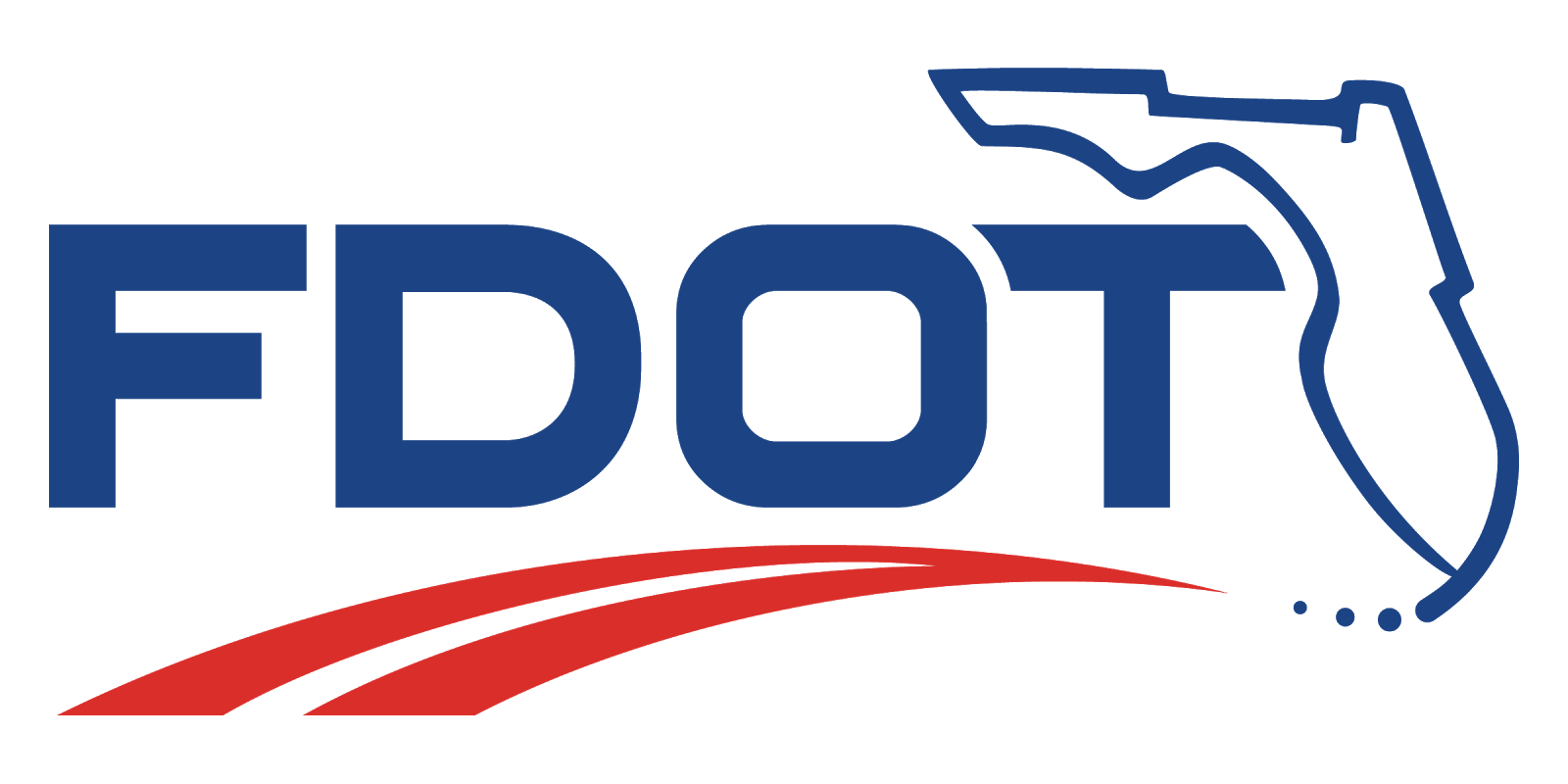
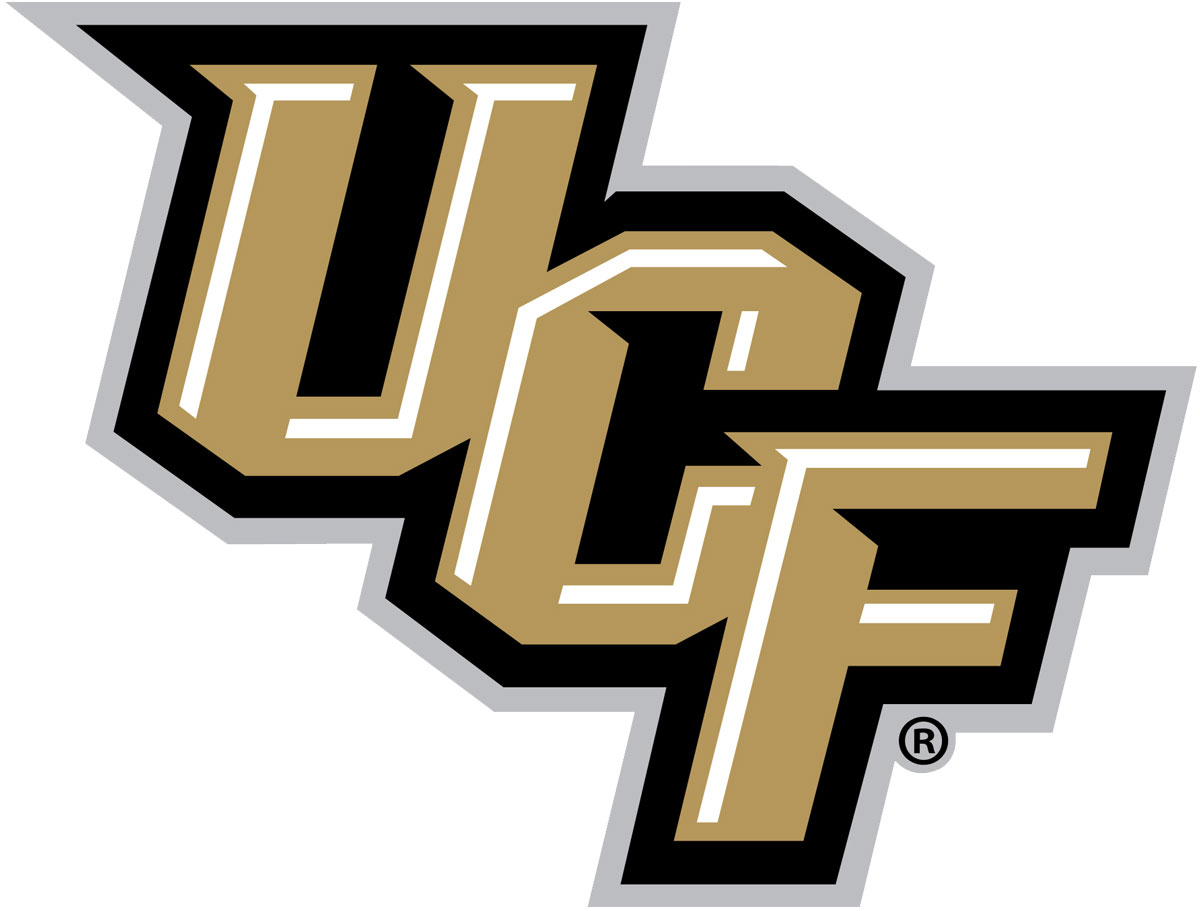

PedSafe
PedSafe is an innovative pedestrian and bicycle collision avoidance system being designed by FDOT. Drivers will be alerted when a pedestrian or cyclist is in the area. Also, traffic signals will be designed to become aware of pedestrians crossing the road. PedSafe will connect advanced signal controller capability, use Connected Vehicle technologies, and existing communication capabilities to reduce the occurrence of pedestrian and bicycle crashes. The application will be easily transferable throughout the country. This system will also be tested in the Pine Hills, a community that has faced significant challenges with pedestrian safety.
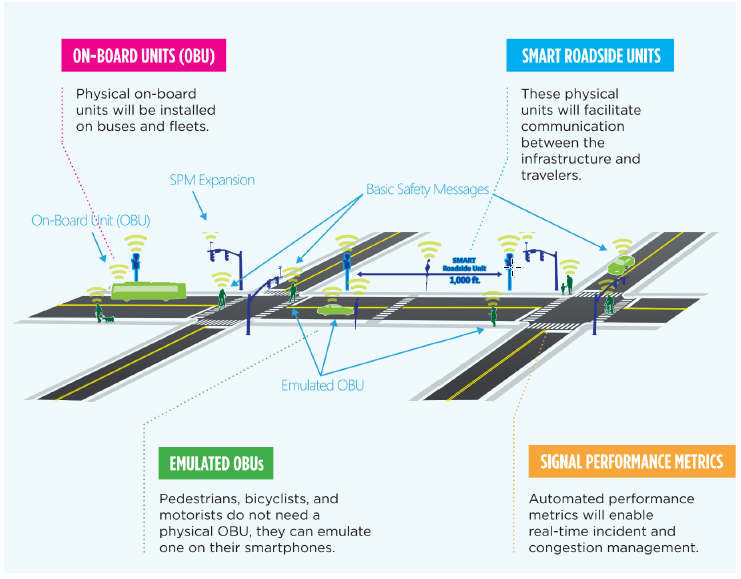
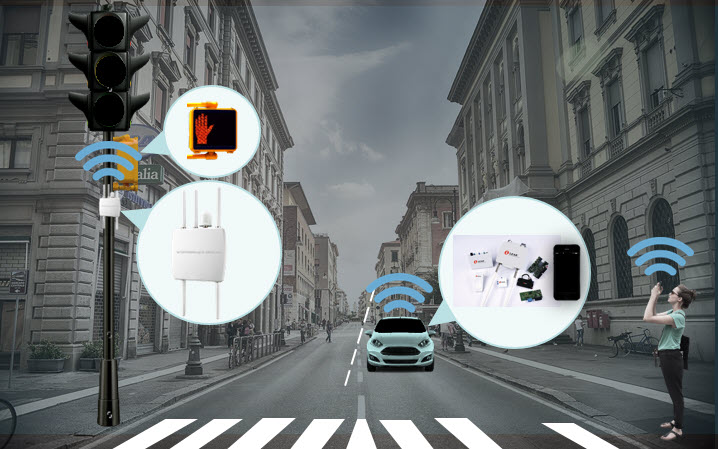
SR 434 CV Pilot
I-75 FRAME The I-75 FRAME (
Florida's
Regional
Advanced
Mobility
Elements)
project is located on the I-75 and US 301/441 corridors,
connecting east-west arterials between these two corridors.
The purpose of this project is to reroute the I-75 traffic
during emergencies and incident managements to US 301/441
using east to west arterials as SR 500, SR 200 and SR 40.
These efforts are part of the 2016 Central Office ATCMTD
application to lessen the recurring and non-recurring congestion
on I-75 between Gainesville and Wildwood/Ocala region. The project
length comprises of FDOT Districts 2 and 5 jurisdictions where
the northern and southern areas of this regional effort are
located. Each District will lead the efforts of their
areas which will deploy CV Technologies to better manage,
operate, and maintain the multi-modal system and create an
integrated corridor management solution. This includes the
deployment of Automated Traffic Signal Performance Measures
(ATSPM); RSUs and on-board units (OBUs); transit signal
priority (TSP);
pedestrian safety elements, and adding fiber optic cable on
US 301/441 gaps. The goal of the project is to disseminate
real-time information to the motorists during freeway incidents.
To access the
2016 ATCMTD Grant Application click
here.
 The
Florida Department of Transporation (FDOT) DISTRICT 5 is
working on the SR 434 CV PILOT. This project is located
in Seminole County, north of the University of Central
Florida (UCF) on SR 434, from north of McCulloch Road to
east Mitchell Hammock Road. This Connected Vehicle pilot
serves as a starting point for the PedSafe Greenway
Deployment Project. This project will include Connected
Vehicle technologies (DSRC, RSU, OBU) with CV
applications like Pre-emption, Transit Priority Signal,
Signal Performance Metrics and Signal Phasing and
Timing, as well as others.
The
Florida Department of Transporation (FDOT) DISTRICT 5 is
working on the SR 434 CV PILOT. This project is located
in Seminole County, north of the University of Central
Florida (UCF) on SR 434, from north of McCulloch Road to
east Mitchell Hammock Road. This Connected Vehicle pilot
serves as a starting point for the PedSafe Greenway
Deployment Project. This project will include Connected
Vehicle technologies (DSRC, RSU, OBU) with CV
applications like Pre-emption, Transit Priority Signal,
Signal Performance Metrics and Signal Phasing and
Timing, as well as others.
Since CV/AV technology is a new and rapidly
evolving, and design standards and specifications are under development,
a three-phased testing plan for the FRAME project
is currently underway. Those three phases are
signal shop (lab) testing, TERL testing, and
on-site testing. District Five has recently undergone the lab
testing component. The goal of this test was to
evaluate communication between devices
(primarily conversion of NTCIP to SAE J3725) and
compatibility with existing infrastructure to
ensure interoperability of applications across
the District. In a lab
environment, the various RSUs and OBUs were
tested to determine if full end-to-end
communication such as basic safety messages
(BSMs), map messages (MAP), and signal phasing and timing (SPaT)
data were being transmitted and received
successfully. The lab setup included four
(4) controller manufacturers, seven (7) RSU
manufacturers, and five (5) OBU manufacturers
devices. Lab tours
and presentations were conducted with the goal
of providing attendees with an opportunity to
see the first phase of the signal shop testing
in person. To access a copy of the
presentation, click
here. With the lab testing phase
completed, field testing is currently being
scheduled. This would involve mounting the RSUs
at viable intersections given the various
controller types available by county. Field
tests will include the testing of the various
messages described above with the addition of emergency vehicle pre-emption (EVP) as well as
TSP. Checks and
balances will be validated to ensure that the
equipment works within a "live" environment.
FUTURe CITy Initiative
The FUTURe CITy (Fostering Smart Urban Transformation and Ubiquitous Resilience with Connected Infrastructure and Technology) initiative at UCF is a group of researchers who have a vision to synergistically explore the wide-ranging technological advances in the service of urban residents. This initiative will provide a blue print to urban policy makers to optimally allocate limited resources while meeting sustainability and resilience goals and promoting social justice, equity, and fairness. Areas of interest of this initiative include Smart Transportation, Smart Infrastructure Systems, Smart Disaster Management, Smart Inter-disciplinary Techniques, Smart Water/Waste Water Management, Smart Health, Smart Tourism, Smart Policies, and Smart Geotechnics. For more information, click
here.
UCF Test Bed
Colonial Parkway
The Florida Department of Transportation (FDOT),
Florida’s Turnpike Enterprise has recently
started the Colonial Parkway Project Development
and Environment (PD&E) Study. The study limits
are along State Road 50 (SR 50), also known as
East Colonial Drive, from Woodbury Road (near SR
408) to SR 520, approximately 7 miles in length
in eastern Orange County, Florida. Building on
previous studies, Florida’s Turnpike Enterprise
initiated this PD&E study in September 2017 to
develop new alternatives to meet the future
mobility needs along the existing SR 50
corridor.
This study will consider connected and
autonomous vehicles technologies. Autonomous or
self-driving vehicles are projected to provide
significant safety benefits including up to 80%
reduction in vehicle accidents. For more
information on this study, click
here.
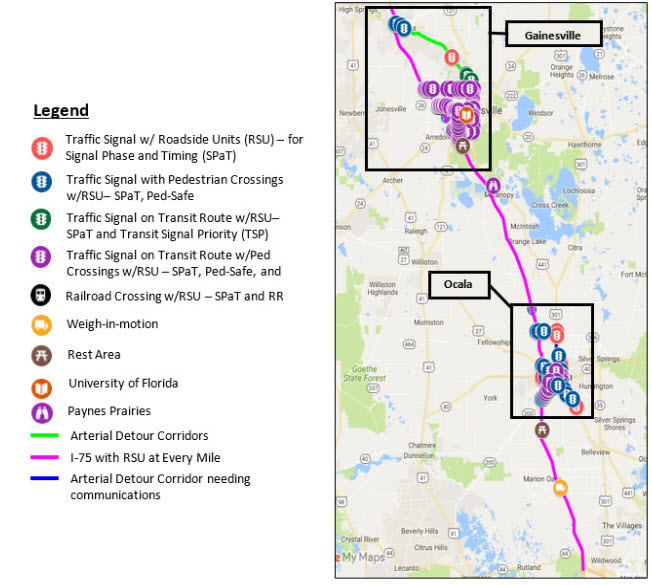
FRAME CV
Testing


The Florida Department of Transportation District 5, City of Orlando and the University of Central Florida (UCF) have committed to the construction of testing grounds in and around the east Orlando area of the UCF main campus. This effort is rooted in a regionwide emphasis around USDOT's Smart Cities initiative, which focuses on ways to use technology to improve quality of life. The SmartCommunity site, rich with multimodal traffic demand, is being developed to test integrated solutions to connect people to the places and services that they need. Anticipated features include a 38-signal testbed of connected infrastructure equipped with ATC controllers, DSRC radios, passive pedestrian detection, CCTV, in-pavement sensors, automated shuttle service and mobility kiosks. Additionally, UCF is home to the Institute for Simulation and Technology (IST), the Cognitive Sciences Laboratory component of IST, is a critical component in both the CV environment and autonomous advancement from Level 2 to Level 5 technologies. These features combined with integrated data collection will provide a proving ground for CV applications, AV integration to mixed traffic, Advanced parking management strategies and Mobility on Demand framework. Areas of research include safety, advanced parking management, data management, mobility on demand, OBU emulation, and human machine interface.

